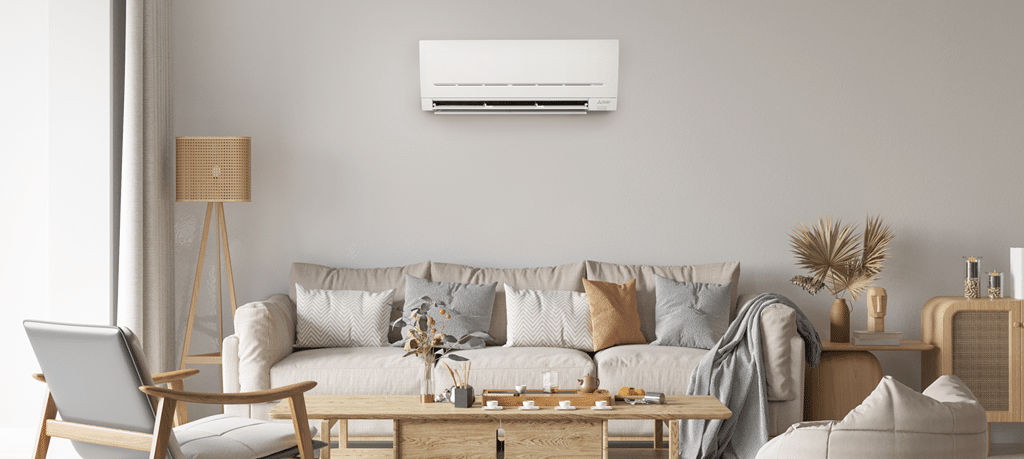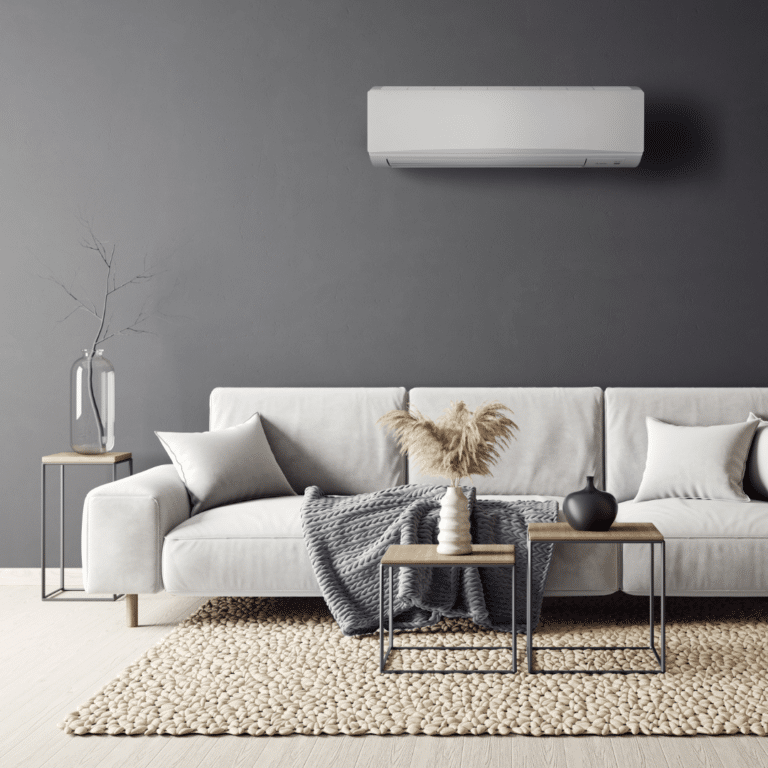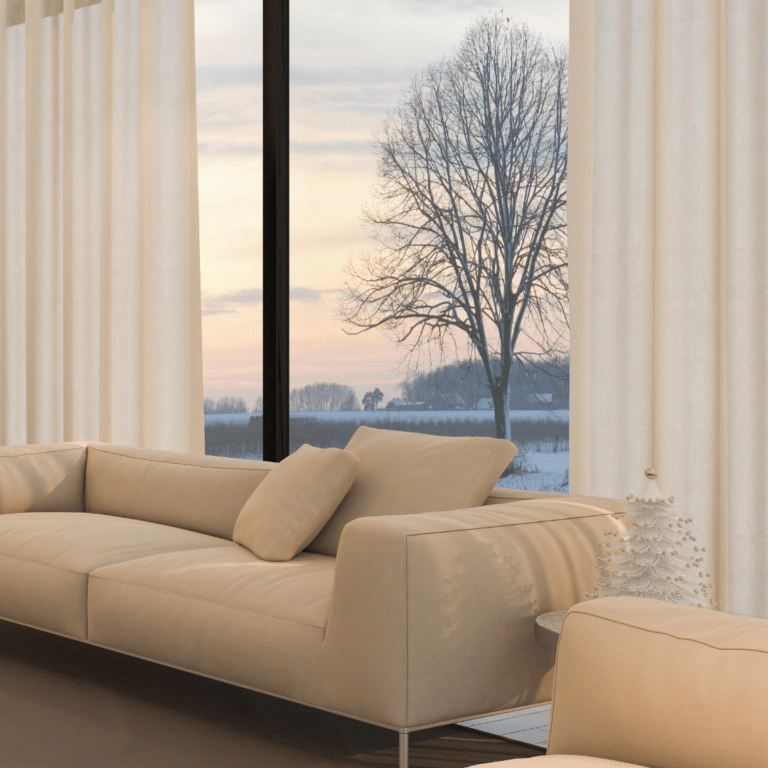Many homeowners find it challenging to know where to begin with the wide range of air conditioning systems available. Factors like room size, insulation, energy ratings, and installation requirements all influence which system will deliver the best results. Whether upgrading an old unit, building a new home, or fitting out a rental, understanding your options is essential to avoid costly mistakes. This guide breaks down the main types of air conditioners, explains how to choose the right capacity, and highlights key features that can enhance comfort and efficiency. By the end, you’ll be better equipped to select a system that suits your home, lifestyle, and long-term needs.
Which Air Conditioner Is Right for You?
Selecting the right air conditioner is an important decision that depends on various factors, such as your home’s size, climate, and specific comfort requirements. House design, the number of windows, insulation quality, and available wall or ceiling space can all present unique challenges when determining the best system for your needs. Evaluating your options and understanding how each system works will help ensure you make the best choice for your household.

Wall Mounted Air Conditioners
As the name suggests, wall mounted air conditioners are split systems specifically designed for installation on walls. They are an excellent choice for cooling and heating individual rooms, providing efficient climate control for single spaces. With their sleek and compact design, wall mounted units blend seamlessly into most interiors while occupying minimal space.
Optional features such as allergen filtration and air purification make them ideal for households where indoor air quality is important. Additionally, wall mounted units are available in various colours, including white, black, silver, and red, allowing you to match the unit to your interior design.
Multi Split System
Perfect for homes with multiple rooms and individual temperature control requirements, multi split system air conditioners are a versatile choice. They connect multiple indoor air conditioning units to one outdoor unit, providing flexibility and efficiency. While each indoor unit can be set to a different temperature, all units connected to the same outdoor unit must run in the same mode—either heating or cooling. This makes multi split systems a practical solution for homes where different areas require independent temperature adjustments within a shared operating mode.
Another key benefit of multi split systems is the ability to mix and match different indoor unit types to suit each room’s specific needs. For example, you can have a wall-mounted unit in a bedroom, a floor console in the lounge room, and a bulkhead unit in the dining or kitchen area. This flexibility allows you to optimise comfort, design, and space efficiency throughout your home. Additionally, multi split systems offer a space-saving solution by minimising the number of outdoor units required, making them particularly beneficial for properties with limited exterior space.
Ducted Air Conditioning
Ducted air conditioning systems offer a comprehensive solution for whole-house temperature control, seamlessly integrating into your home with only the vents visible. These systems use a network of ducts to distribute air evenly throughout the space, providing cooling and heating options. Adding optional zoning allows you to customise airflow in different areas of the home. Whether for small residences, large open-plan layouts, or multi-level homes, ducted systems deliver powerful performance while maintaining a clean and uncluttered aesthetic.
The power supply options for outdoor units depend on their capacity. Smaller capacity units are typically available in single-phase, while larger capacity models come in a three-phase power supply. To bridge the gap between power requirements, Mitsubishi Electric has released a 16kW outdoor unit for ducted systems, available in both single-phase and three-phase. This provides greater flexibility for installers when selecting a system that aligns with a home’s electrical setup.
Floor Console
Floor consoles are installed at floor level, making them ideal for rooms with limited wall or overhead space. Their design allows piping and electrical connections to pass through the floor, providing versatile installation options for various room layouts. Floor consoles are particularly effective in heating modes, as they distribute warm air evenly across the room, ensuring consistent and comfortable temperatures throughout the space. The MFZ-KW Series exemplifies this versatility, accommodating a range of modern interior and heritage-listed properties with specific installation requirements. In South Australia, the Mitsubishi Electric floor mount series is only available as a multi-split system.
Ceiling Cassette
Ceiling cassette air conditioners are designed for spaces with limited wall or floor space. These units are installed in the ceiling and distribute air evenly across the room. They are ideal for commercial settings, office spaces, apartments or large open-plan home areas. Smaller 1-way flow models are ideal for bedrooms and apartments. Ceiling cassettes are available in single-split systems or in a multi-split system.
Bulkhead
Compact and designed to blend seamlessly into bulkheads or drop ceilings, these air conditioners are ideal for limited spaces where traditional units may not fit. With a low-profile design, they integrate discreetly into your home without compromising its style. Their slim build makes them suitable for low ceiling areas or concealed installations, such as above wardrobes or in apartments. Bulkhead units offer quiet, efficient operation and are perfect for bedrooms, studies, or living spaces. They provide the functionality and comfort of a split system while addressing space constraints that may otherwise limit your options. Bulkhead units are also available as a single-split system or part of a multi-split system.
Split Systems
Split system air conditioners are popular for home heating and cooling due to their energy efficiency and versatility. Technically, any air conditioning system with separate indoor and outdoor units falls under this category. These systems connect the indoor unit to the outdoor unit via refrigerant gas pipes, allowing for precise temperature control and quiet operation.
Split systems are available in various types, making them suitable for different applications and spaces. The variety of split system types addresses design challenges, such as limited wall space, ceiling constraints, or aesthetic preferences. Their straightforward installation and user-friendly operation make them ideal for homes and apartments, especially in areas with limited floor or ceiling space.
What size air conditioner do I need?
Choosing the right size air conditioner for your home is crucial to ensure efficient cooling or heating while keeping energy costs in check. An incorrectly sized system can lead to unnecessary expenses, discomfort, and maintenance issues. Here’s what you need to know to make an informed decision.
Why Air Conditioner Size Matters
The size of an air conditioner is determined by its cooling and heating capacity, measured in kilowatts (kW). Selecting the right capacity is important to avoid these issues:
- Undersized Systems: These will operate at maximum capacity for prolonged periods, leading to higher energy bills, faster wear and tear, and failure to achieve the desired temperature. A system that is undersized for heating could potentially go into Defrost Mode too frequently.
- Oversized Systems: These can short-cycle, causing inconsistent temperatures, higher initial costs, and increased maintenance needs.
Factors That Influence Air Conditioner Sizing
Determining the appropriate size of your air conditioner isn’t as simple as looking at the square meterage of your home. A professional Heat Load Calculation is essential to account for a wide range of factors, including but not limited to the following:
- Geographic Location: Your local climate significantly impacts the cooling and heating requirements.
- Building Orientation: The placement of your home, including which sides face the sun, affects heat gain.
- Insulation Quality: Homes with good insulation retain cool air better in summer and warm air in winter.
- Windows and Doors: The size, type, and orientation of windows and doors can significantly influence heat loss or gain.
- Construction Materials: The type and thickness of walls, roofing, and flooring affect heat retention.
- Physical Dimensions: The space’s length, width, and height directly affect the volume of air to be cooled or heated.
- Ceiling Height: Taller ceilings mean more air volume to cool or heat.
- Occupancy and Activities: The number of people and the activities inside your home contribute to heat generation.
- Lighting and Appliances: Heat from lighting and electrical appliances adds to the overall load. For example, computers and multiple monitors can generate heat.
The Importance of a Professional Heat Load Calculation
A Heat Load Calculation evaluates all the factors influencing your home’s cooling and heating needs to recommend the correct kW capacity for your air conditioning system. This process ensures the selected unit will provide optimal performance without overloading or wasting energy.
Professional air conditioning specialists, such as Mitsubishi Electric Diamond Dealers, have the expertise to perform detailed heat load calculations. These professionals use industry-standard methods to estimate the peak and partial load requirements of your space, ensuring a tailored solution for your home.
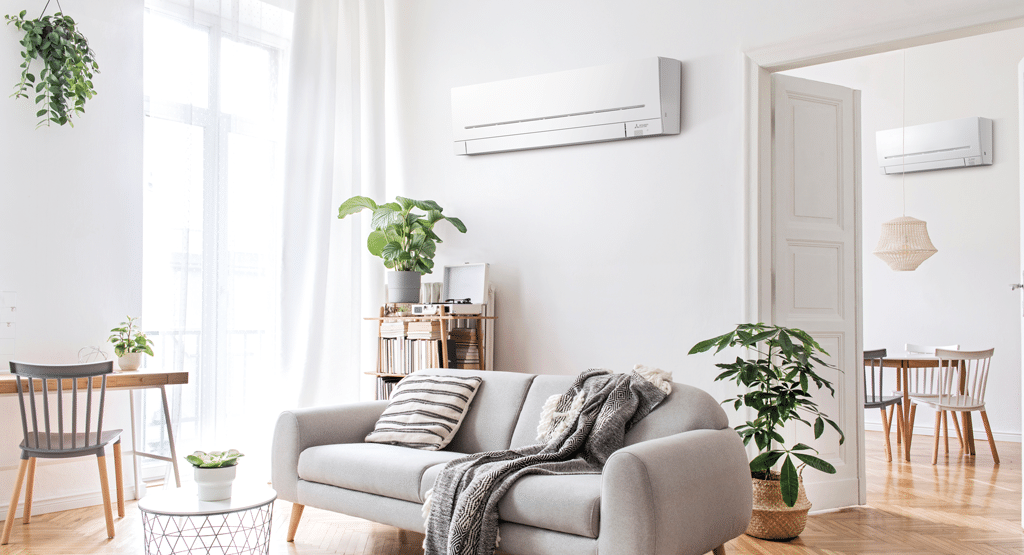
Can I use one air conditioner for multiple rooms?
Whether an air conditioner can effectively cool or heat multiple rooms depends on its capacity (kW) and the size of the area. For example, if your lounge room, living room, and kitchen require a 7.1kW system, a 7.1 kW unit will be sufficient for those spaces but may struggle to extend its reach and air condition additional rooms.
Multi-split systems and ducted air conditioners are designed to heat or cool multiple rooms efficiently for whole-home or multi-room solutions. Multi-split systems allow different indoor units to connect to a single outdoor unit, while ducted air conditioners distribute air through ceiling vents for even temperature control.
To determine the best system for your home, consider which rooms need air conditioning and consult an air conditioning specialist to ensure you choose a unit with the right capacity and setup.
How does insulation affect air conditioner size?
Insulation plays a critical role in determining air conditioner size. It helps maintain the room’s temperature by reducing heat gain or loss. Well-insulated rooms can often be cooled or heated with lower-capacity units as they retain the desired temperature more effectively than poorly insulated spaces.
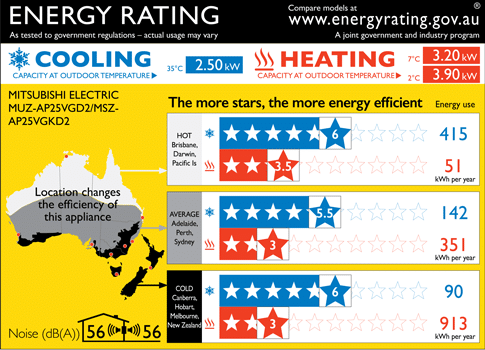
How do energy ratings affect running costs?
Energy ratings, represented by star labels, clearly compare an air conditioner’s efficiency. Units with higher star ratings use less energy to achieve the same performance, resulting in lower running costs. While models with higher ratings may have a higher upfront cost due to advanced technologies, they offer significant savings on electricity bills over time. Additionally, the Zoned Energy Rating Label (ZERL) provides a more detailed performance assessment across different climate zones. These labels estimate annual electricity usage based on standby power, climate data, and each zone’s specific heating or cooling needs. Choosing a high-star rating model is an investment in long-term efficiency. For more details about energy labels, visit the Energy Rating website.
Other Features to Consider
So far, we have covered the most important features of air conditioning units. However, there is more to explore and consider when selecting the right system.
Noise Levels
Noise levels are an important consideration when selecting an air conditioner, as quieter models provide greater comfort and usability. Lower decibel (dB) ratings indicate quieter operation, which is particularly beneficial for bedrooms and living areas. Features such as Night Mode, available in the Mitsubishi Electric AP series, further enhance quiet operation by disabling alert beeps and reducing the noise level of the outdoor unit by up to 3 dB. Quiet outdoor units are equally important, helping avoid disturbances for your household and neighbours. Selecting an air conditioner with optimised noise performance ensures a more pleasant environment indoors and out.
Remote Controls and Smart Home Compatibility
Air conditioning units, such as wall mounted units, will come with a handheld remote control. Ducted air conditioners and other systems will have a wall controller.
For extra convenience, look for Wi-Fi control compatibility*1 , which allows you to integrate it into your home automation systems, such as Amazon Alexa*2 or Google*3 . This feature enables remote operation and scheduling via smartphones or tablets and can be a great option to ensure you arrive home from work in the perfect home temperatures.
*1 Optional Wi-Fi adapter required per unit (excludes Mitsubishi Electric models with built-in capabilities).
Requires an Internet connection and the App downloaded from the App Store or Google Play Store on your smartphone or tablet with the latest Operating System available.
*2 To use Amazon Alexa to control your air conditioner, you will need an Amazon Alexa Echo device.
*3 To use Google Assistant to control your air conditioner, you will need a Google Home smart speaker.

Air Purification
Optional air purification filters can significantly enhance indoor air quality by reducing allergens, pollutants, and other airborne particles. Mitsubishi Electric offers advanced solutions such as the Plasma Quad Plus filter and the Plasma Quad Connect:
- Plasma Quad Plus Filter: Standard in the MSZ-LN series, this filter uses plasma technology to significantly improve indoor air quality by inhibiting six key indoor pollutants: Influenza virus, bacteria, PM2.5, allergens, mould, and dust. Its advanced filtration capacity is similar to that of HEPA filters, making it particularly effective for capturing fine particles and ensuring a healthier environment.
- Plasmas Quad Connect: This optional add-on filtration unit delivers the same high-performance filtration as the Plasma Quad Plus. It suits selected Mitsubishi Electric wall-mounted, ducted, and ceiling cassette units. Available models (see flyer for fitment requirements):
- MAC-100FT-E – for MSZ-EF, MSZ-AP, MSZ-GN, PKA-M, PKFY-P, PKFY-WL wall mounted
- MAC-100FT-E – for SEZ, PEFY-P/WP VMS1, PEAD, PEFY-P/WP VMA ducted units
- PAC-SK51FT-E – PLA, PLFY-P/WL VEM cassette units
Read our blog Understanding Your Air Conditioner’s Filters to learn more about the different types of filters available.
Installing an air conditioner
Your new air conditioning unit or system requires professional installation to ensure safety, efficiency, and optimal performance. Improper installation can result in poor functionality, increased energy consumption, system faults, or damage to the unit.
General Requirements
- Refrigerant Handling Licence: Any person installing or servicing air conditioning equipment must hold a Refrigerant Handling Licence. Verify your installer’s credentials at Look for the Tick.
- Electrical Licence: A licensed electrician must perform all electrical work to comply with safety regulations and legal requirements.
Installation Considerations
- Placement of Indoor and Outdoor Units:
- Indoor units should be positioned to maximise airflow and minimise obstructions for efficient operation.
- Outdoor units need to be placed in well-ventilated areas to prevent overheating or overcooling and reduce noise impact.
- Wiring and Piping:
- Proper routing of electrical wiring and refrigerant pipes is essential for safe and efficient operation. Longer distances between indoor and outdoor units will require more wiring and refrigerant piping.
- Drainage:
- A reliable drainage system is critical to prevent water leakage or damage. Ensure condensate drains are installed with proper slope and routing.
- New Builds:
- If you are adding air conditioning as part of a new build, consult an air conditioning specialist early in the planning process. They can coordinate a “rough-in” with your builder, allowing ducting, piping, or electrical work to be installed before internal finishes like gyprock are completed.
- For ducted systems, units can be placed inside the ceiling space before the ceiling is installed, simplifying installation and avoiding later disruption.
When to Buy an AC
Purchasing an air conditioner outside of peak summer offers several advantages, particularly when it comes to availability and installation. During the summer months, demand for air conditioners spikes, leading to longer wait times for delivery and installation and potential stock shortages for popular models. By buying in the off-season, you can avoid these delays and have more flexibility in choosing the right system for your needs. Installers are also more likely to have availability, allowing you to schedule installation at a convenient time without the rush of peak-season bookings.
Buying ahead of summer also gives you time to research the best system for your home and ensure it’s installed before the heat arrives. This means you can test the unit, make any necessary adjustments, and be confident that your air conditioner is ready to provide reliable cooling when you need it the most.
For a deeper dive into the benefits of off-season purchasing, read our blog post: Benefits of Buying an Air Conditioner During Winter.
After-Sales Support: Ensuring Peace of Mind
When purchasing an air conditioner, after-sales support is just as important as the product itself. Mitsubishi Electric has operated in Australia for 50 years, providing reliable service and support to ensure each system continues to perform at its best.
Locally Managed Service Requests
The locally based Customer Care team handles all service requests. Calling for assistance means speaking with a dedicated team member who can provide troubleshooting, technical support, and service requests. Whether spare parts are needed or an in-home assessment is required, help is readily available.
📞 Need help? Call 1300 651 808 (Mon-Fri, 8:30 am – 5:00 pm AEST)
🔗 Or lodge a service request online
Accredited Service Providers
A carefully selected team of Accredited Service Providers (ASPs) is available across Australia, trained specifically to service and diagnose air conditioning systems. These providers undergo ongoing training and are equipped with the latest tools to ensure high-quality service.
Genuine Spare Parts
Functional service parts remain available for products up to 10-15 years old, ensuring long-term support for both new and existing customers. To minimise downtime, spare parts are warehoused locally in Sydney, Brisbane, Melbourne, Adelaide, and Perth for quick delivery.
Technical Support & Continuous Improvement
Same-day technical support is available to customers and technicians for additional assistance. Mitsubishi Electric provides technicians access to over ten years of product manuals, ensuring quick resolution of issues. Any quality-related concerns are reported to the factory quality assurance teams in Japan, contributing to ongoing product improvements.
With strong customer support and dedicated service teams, help is always available when needed.
Making the Selection with Mitsubishi Electric
After reviewing your home’s needs, size, capacity required, and costs, you should be more than prepared to decide. By understanding each factor and using this guide, you can make an informed decision that ensures the comfort and efficiency of your home’s climate control. Consider Mitsubishi Electric as your choice for year-round temperature control and versatile options by speaking with a specialist today.
